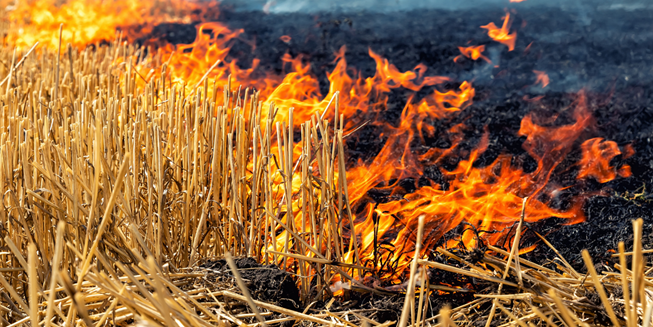Context
Recently, the Delhi government announced that it would spray Pusa bio-decomposer free of cost over 5,000 acres of paddy fields in the city as this would help in controlling stubble burning and air pollution during winter.

What is Stubble Burning?
- Stubble burning is the intentional burning or setting on fire of crop residue to remove them from the field in order to sow the next crop.
- Leaving stubble on the field will invite termites and other pests which can damage the subsequent crop.
- In Punjab and Haryana, farmers burn the stubble (rice chaff) left after the rice harvest so that the field may be readied for the next Rabi (winter) crop like wheat.
- In these areas, it begins around October, the same time at which the southwest monsoon withdraws.
- Section 188 of the Indian Penal Code (IPC) makes stubble burning a crime.
- Additionally, it was notified as an offence under the Air (Prevention and Control of Pollution) Act, 1981.
- Despite being banned, the practice continues in India, where farmers cite a lack of viable alternatives to clear their fields of stubble.
Effects of Stubble Burning
- Pollution: Emits large amounts of toxic pollutants in the atmosphere which contain harmful gases like methane (CH4), Carbon Monoxide (CO), Volatile Organic compounds (VOC) and carcinogenic polycyclic aromatic hydrocarbons.
- These pollutants disperse in the surroundings, may undergo a physical and chemical transformation and eventually adversely affect human health by causing a thick blanket of smog.
- Soil Fertility: Burning husk on the ground destroys the nutrients in the soil, making it less fertile.
- Heat Penetration: The heat generated by stubble burning penetrates into the soil, leading to the loss of moisture and useful microbes.
Alternatives to Stubble Burning
- Turbo Happy Seeder (THS) machine: One such method is using a Turbo Happy Seeder (THS) machine, which can uproot the stubble and also sow seeds in the area cleared. The stubble can then be used as mulch for the field.
- In-situ treatment of stubble: The government is currently giving equipment to farmers to mix the stubble back into the soil so that they do not have to burn it.
- Ex-situ treatment: Under this, some companies have started collecting stubble for their use, but we need more action on this front.
- Changing cropping pattern: It is the deeper and more fundamental solution.
- Subsidise crops other than paddy, the source of most stubble burning. Policy and money should incentivise farmers in the region to plant more fruits and vegetables. India needs more vitamins and protein rather than wheat and rice." This will create more greenery and since vegetable and fruit crops don't leave stubble, it'll bring down the number of open fires.
About PUSA Decomposers
- The decomposers are in the form of capsules made by extracting fungi strains that help the paddy straw to decompose at a much faster rate than usual.
- The fungi help to produce the essential enzymes for the degradation process.
- Process: It involves making a liquid formulation using decomposer capsules and fermenting it over 8-10 days and then spraying the mixture on fields with crop stubble to ensure speedy bio-decomposition of the stubble.
- The farmers can prepare 25 litres of liquid mixture with 4 capsules, jaggery and chickpea flour.
- The mixture is sufficient to cover 1 hectare of land.
- It takes around 20 days for the degradation process to be completed.
- It does not give enough time for farmers to prepare fields for the wheat crop on time.
Significance
- The decomposer improves the fertility and productivity of the soil as the stubble works as manure and compost for the crops and lesser fertiliser consumption is required in the future.
- The soil loses its richness due to stubble burning and it also destroys the useful bacteria and fungi in the soil, apart from causing harm to the environment.
- It is an efficient and effective, cheaper, doable and practical technique to stop stubble burning.
- It is an eco-friendly and environmentally useful technology and will contribute to achieving the Swachh Bharat Mission.
|
